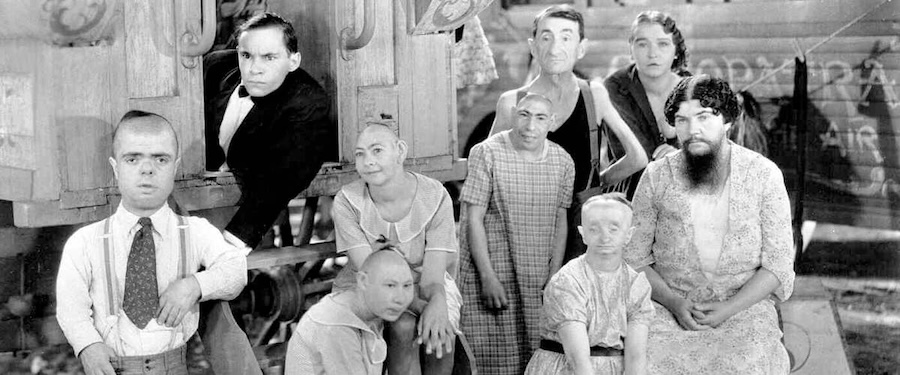
THE STORY OF THE LOVE LIFE OF THE SIDESHOW.

This film did not have a smooth beginning. During shooting, there were people working for MGM who were openly uncomfortable with having ”freaks”, performers with disabilities, on the studio lot. Test screenings did not go well and Irving Thalberg stepped in, without director Tod Browning’s consent, making sure that many ingredients were cut, shortening a 90-minute feature to 64 minutes. The only reason the movie is even that long is because some additional material was filmed in order to extend the running time.
The rejected scenes are lost, as far as we know, but they would be amazing to see. We’re talking comedy bits, a scene that reveals the awful fate of one of its villains, and a considerably longer version of that most famous sequence, where the ”freaks” attack the dastardly Cleopatra. As it stands now, Freaks would definitely benefit from a more developed story.
Keeping the relationship a secret
We’re introduced to the people who are part of a carnival sideshow. The show’s most beautiful man and woman, a trapeze artist called Cleopatra (Olga Baclanova) and a strongman called Hercules (Henry Victor), are a couple but keep their relationship a secret. The reason is dark: Cleopatra is wooing Hans (Harry Earles), a dwarf who supposedly has a large fortune, hoping to lay her hands on it and escape with Hercules. Hans has a fiancée, Frieda (Daisy Earles), who’s also a dwarf and can see right through Cleopatra. But she feels helpless as Hans clearly responds to the pretty lady’s advances. A wedding is planned, but that’s where everything is revealed and the knives come out…
Rejecting accusations
There were accusations against Freaks at the time of its premiere that it was exploiting people with disabilities, the actors who play the ”freaks”. They include conjoined twins, little people (Harry and Daisy Earles were in fact siblings, not lovers, and would go on to play Munchkins in The Wizard of Oz (1939)), men and women without arms or legs, and Schlitzie, a sideshow performer with an unusually small skull and an intellectual disability, who played himself. MGM rejected those accusations and pointed out in their marketing: ”What about abnormal people? They have their lives, too!” They were absolutely right and subsequent scholars have lifted the portrait of the ”freaks” as a positive thing. It was done with compassion, showing them as people functioning like everybody else, with everyday concerns, interacting with their able-bodied colleagues at the carnival. They are the heroes of the film and we certainly root for them as they strike back at Hercules and Cleopatra near the end of the film.
The scene is startlingly effective, but this isn’t really a horror movie.
Sometimes it is labeled a horror movie because of its most famous scene, that has the ”freaks” crawling in the rain and mud toward a trapped Hercules. Perhaps the fact that Browning made Dracula the previous year also has something to do with it. The scene is startlingly effective, but this isn’t really a horror movie. It’s more of a wicked fairy tale, if anything, with its heart in the right place.
A box-office failure, the film was banned in places for decades, but rediscovered in the 1960s and has become a classic since. Over-the-top for sure! But Browning’s own past in vaudeville is probably one reason why it also comes across as heartfelt.
Freaks 1932-U.S. 64 min. B/W. Directed by Tod Browning. Screenplay: Willis Goldbeck, Leon Gordon. Short Story: Tod Robbins (”Spurs”). Cast: Wallace Ford (Phroso), Leila Hyams (Venus), Olga Baclanova (Cleopatra), Rosco Ates, Henry Victor, Harry Earles, Daisy Earles.
Trivia: Victor McLaglen, Myrna Loy and Jean Harlow were considered for the leads.
Quote: “We accept you, one of us! Gooble Gobble!” (The “freaks”)
Last word: “Tod Browning, I loved him. He say, ‘I want to make a picture with you, Olga Baclanova… Now I show you with whom you are going to play. But don’t faint.’ I say, ‘Why should I faint?’ So he takes me and shows me all the freaks there. First I meet the midget and he adores me because we speak German and he’s from Germany. Then he shows me the girl that’s like an orangutan; then a man who has a head but no legs, no nothing, just a head and a body like an egg. Then he shows me a boy who walks on his hands because he was born without feet. He shows me little by little and I could not look. I wanted to cry when I saw them. They have such nice faces, but it is so terrible… Now, after we start the picture, I like them all so much.” (Baclanova, “Women in Horror Films, 1940s”)
